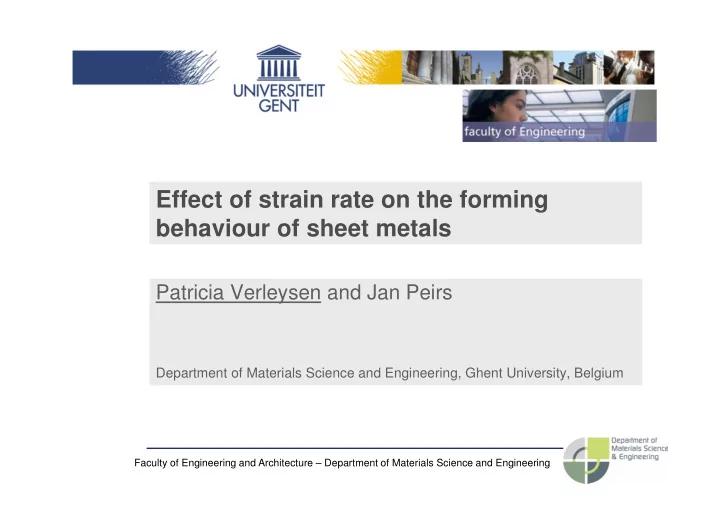

Effect of strain rate on the forming behaviour of sheet metals Patricia Verleysen and Jan Peirs Department of Materials Science and Engineering, Ghent University, Belgium Faculty of Engineering and Architecture – Department of Materials Science and Engineering
DC06 1mm 500 RD 1100 s-1 450 HSR RD 380 s-1 Energy 400 RD 5.10-³ s-1 350 Stress (MPa) 300 Forming of 250 sheet metals 200 static 150 100 Forces Forming limits 50 0 0.00 0.10 0.20 0.30 0.40 0.50 0.60 Deformation
Processes and materials of interest • Electromagnetic pulse forming, hydroforming Strain rates upto 3500/s • Deepdrawing, roll forming, bending Locally strain rates upto 100/s • DC04 (EN 10027-1) unalloyed deep-drawing steel used for body components in cars • CMnAl TRIP laboratory made multiphase austenite transforms to martensite during plastic straining
Overview • Experiments • Modelling of high strain rate behaviour • Calculation of high strain rate FLD • Conclusions
Overview • Experiments • Modelling of high strain rate behaviour • Calculation of high strain rate FLD • Conclusions
Split Hopkinson tensile bar experiments Loading wave transmitted wave length � � � � loading duration Reflected wave
Split Hopkinson tensile bar experiments Setup at Ghent University - Uniaxial tensile load - Adjustable strain rate up to ~2000 s -1 - Loading time up to 1.2 ms - Specimen glued between bars Before testing After testing
Test results Dynamic UE < 10% Static UE � 20%
Test results Dynamic UE � 30% Static UE � 22%
Overview • Experiments • Modelling of high strain rate behaviour • Calculation of high strain rate FLD • Conclusions
Phenomenological modeling Johnson-Cook ‣ Strain rate dependent hardening ‣ Temperature dependent softening � � m � � � � � � T T � − � � � � ε n � room � � � � � A B 1 C ln 1 σ = + ε + − � � � � � � � � � T T ε − � � � � 0 melt room � � adiabatic heating Voce ‣ Strain rate dependence and adiabatic conditions accounted for by the use of strain rate dependent parameters n − ε K ( 1 e p ) σ = σ + − 0
Modelling DC04
Modelling TRIP
Overview • Experiments • Modelling of high strain rate behaviour • Calculation of high strain rate FLD • Conclusions
Calculation of high strain rate FLD • Marciniak-Kuczynski model initial imperfection in sheet metal modelled by band of smaller thickness during biaxial straining imperfection zone deforms more than uniform zone when strain localizes , difference increases drastically failure of sheet
Calculation of high strain rate FLD orientation of band � � imperfection � f 0 =t b0 /t a0 =0.99 failure if ratio of strain in b to a=4 For a certain predefined biaxial strain state critical strain calculated for all � angles Lowest strain value is THE critical strain
Calculation of high strain rate FLD
Calculation of high strain rate FLD
Overview • Experiments • Modelling of high strain rate behaviour • Calculation of high strain rate FLD • Conclusions
Conclusions • Influence of strain rate on forming properties of DC04 and a CMnAl TRIP steel is studied High strain rate tensile experiments are carried out Johnson-Cook and Voce model parameters determined Experimental results are used to calculate FLDs based on Marciniak-Kuczynski model • Forming limit diagrams show a non-negligible effect of the strain rate DC04 FLD shifts downwards with increasing strain rate TRIP FLD enhances considerably if the strain rate is increased
Remarks • Anisotropy not taken into account in FLDs Limitation due to implementation, not inherent to M-K model – now Hill implemented • Post-necking behaviour not taken into account Better results obtained with shear tests instead of tensile tests
Questions ?? More information: Verleysen, P; Peirs, J; Van Slycken, J; Faes, K and Duchene, L (2011): Effect of strain rate on the forming behaviour of sheet metals. Journal of materials processing technology nr. 8, Vol. 211, 1457-1464 Department of Materials Science and Engineering Mechanics of Materials and Structures Ghent University, Belgium Patricia.Verleysen@UGent.be
Recommend
More recommend